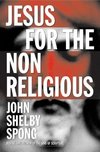Sea of Faith Network
"Exploring and promoting religious
faith as a human creation..."
Sofia — The Sea of Faith (UK) Magazine
Patti Whaley reviews
Jesus for the Non-Religious: Recovering the Divine at the Heart of the Human by John Shelby Spong - HarperCollins (San Francisco). 2007. 336 pages. £14.99. ISBN: 978-0-06-076207-0

Jack Spong’s latest book, Jesus for the Non-Religious, ranks with great religious classics such as The Divine Comedy and The Brothers Karamazov in at least one way: all three promise that the long, arduous journey will have been worthwhile, and all three prove disappointing. The Inferno is infinitely more interesting than the Paradiso; Ivan and Dmitri are much more compelling than Alyosha; and it’s a lot more fun to pull the Jesus myth apart than it is to put it together again.
Jesus is divided into three main sections. Part 1 seeks to demonstrate how many facets of the Jesus story are mythological, including not only the usual birth and miracle stories, but also most of the information about Jesus’ parents, the existence of a well-defined group of twelve disciples, the betrayal by Judas Iscariot, and most of the details of the passion. I would have been glad for more clarity about how much of this material is Spong’s own and how much is borrowed from other New Testament scholars, but Spong provides a clear and well-argued summary of this material.
Part 2 demonstrates that the overriding structures and images of the gospels derive from Jewish liturgy and Hebrew scripture. Not only do the Gospel writers draw heavily on Passover, Yom Kippur, Second Isaiah and Second Zechariah to give shape and resonance to Jesus, but they even organise their material to provide a set of readings to fit the seasonal feasts of the synagogue year. Christians are accustomed to the idea that the Christian liturgical year is structured to fit the events of Jesus’ life; what they don’t realise is that Jesus’ life was itself structured to fit the Jewish liturgical year.
Again, most of this is well-argued, but the occasional reversals of logic can be disconcerting. Throughout the book Spong asserts that many events in the gospels did not really happen, but were gleaned from earlier Hebrew scriptures and used to construct a story that would recall and fulfil the prophecies. Using this logic he argues that there was no disciple named Judas Iscariot, no betrayal by one of the disciples and no thirty pieces of silver. There was no gambling away of Jesus’ clothes, and no thieves on either side of the cross. But when he comes to Mark’s story of how the disciples fled when Jesus was betrayed, he suddenly takes the opposite tack. Mark has Jesus predict the disciples’ flight by quoting Zechariah 13:7: ‘You will all fall away; for it is written, “I will strike the shepherd, and the sheep will be scattered”.’ Spong concludes that the desertion by the disciples is historical, because ‘One does not provide so perfect a “divine justifying explanation” for something that never occurred.’ Hold on – if that is the case, shouldn’t all those earlier bits be reinstated?
Part 3 paints the new human Jesus whom even the non-religious can follow. Spong’s Jesus has three main attributes: he breaks down tribal boundaries, he rises above all prejudices and stereotypes, and he breaks through religious rules and boundaries to call all people to become fully human. This new Jesus requires no belief in supernatural doctrine. Spong does not seek to explain the resurrection, or even to explain why the gospel writers chose resurrection as the central symbol of the Jesus experience. He simply asserts that ‘The first-century experience of Jesus was quite simply that people met God in him…because life, love and being flowed through the fullness of his humanity.’
One can’t really argue with this, but it sounds a lot more like a Jesus well-calibrated both to support long-standing interests of Jack Spong, and to be completely acceptable to a liberal secular audience, than a well-argued portrait of the experience of first-century Christians. We see this most clearly when we realise that nowhere in this book does Spong mention eschatology. The extent to which John the Baptist, Jesus, or Jesus’ followers expected a literal coming of the Kingdom of God, and the impact of this expectation on the Gospel writers, is totally ignored. It’s not clear whether Spong finds these aspects of the Jesus story troublesome, inconvenient, or simply not useful; what is clear is that this Jesus is shaped more by the themes and concerns of Spong’s life than by the experience of the first-century Christians.
Will this book change anyone’s mind? Liberal Christians who already want to follow Jesus without having to believe the unbelievable will find this book accessible, reassuring and possibly even inspiring. Liberal secularists who have already bought into the need to rise above tribal boundaries, prejudices and religious sectarianism may well ask what further need they have for this Jesus; it’s not really clear how life with this Jesus differs from the life of a secular liberal humanist. Can Spong’s new Jesus draw the non-religious back into a new and revitalised experience of God? Regrettably, I don’t think so.
Patti Whaley is a former SoF Chair and currently its Treasurer.

